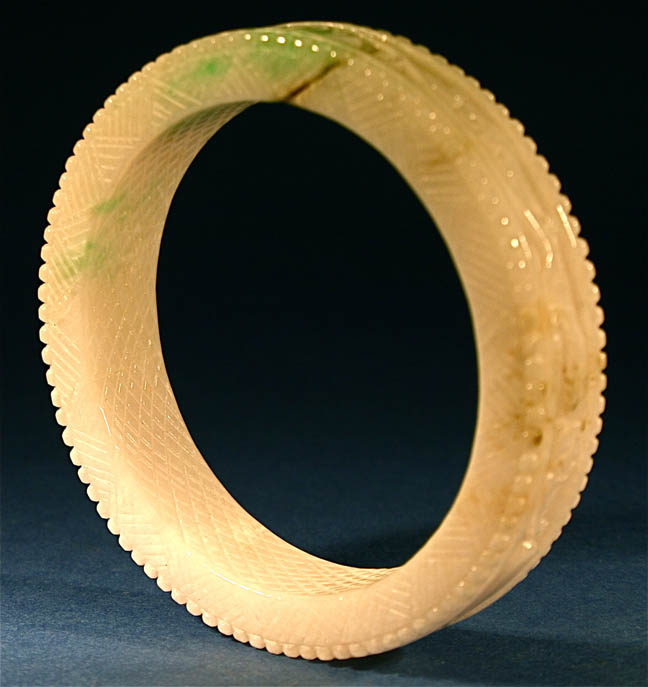

Title: White & Green jadeite Fine Antique Chinese Hand Carved Bracelet
Shipping: $19.00
Artist: N/A
Period: Unassigned
History: N/A
Origin: N/A
Condition: Excellent
Item Date: 20th Century
Item ID: 4574
White and Green jadeite bangle, cylindrical square shape. Very Impressive. Overall it is quite nice and very collectible. A well-carved jadeite Bracelet of purplish white color with splashes of green, carved with a flat interior. Although as with all art its perception is primarily based upon the interpretation and ideas of you the viewer
Link: http://en.wikipedia.org/wiki/Jade
Jade is an ornamental stone. The term jade is applied to two different metamorphic rocks that are made up of different silicate minerals: The English word jade (alternative spellings "jaid", "jadeite") is derived (via French l'ejade and Latin ilia from the Spanish term piedra de ijada (first recorded in 1565) or "loin stone", from its reputed efficacy in curing ailments of the loins and kidneys. Nephrite is derived from lapis nephriticus, the Latin version of the Spanish piedra de ijada. Nephrite and jadeite were used from prehistoric periods for hardstone carving. Jadeite has about the same hardness as quartz, while nephrite is somewhat softer. Both nephrite and jadeite are tough, but nephrite is tougher than jadeite. It was not until the 19th century that a French mineralogist determined that "jade" was in fact two different materials. The trade name jadite (not to be confused with jadeite) is sometimes used for translucent or opaque green glass. Jadeite is one of the minerals recognized as the gemstone jade. The other is nephrite. Jadeite from the Motagua Valley, Guatemala, was used by the Olmec and Maya peoples, as well as the indigenous peoples of Costa Rica. Typically, the most highly valued colors of jadeite are the most intensely green, translucent varieties, though traditionally white has been considered the most valuable of the jades by the Chinese, known for their carefully crafted jade pieces. Other colors, like "Olmec blue" jade, which is characterized by its deep blue-green, translucent hue with white flecking, are also becoming more highly valued because of its unique beauty and historical use by the Mesoamerican Olmec and also in Costa Rica[10]; however, this variety was only recently rediscovered and is only being minimally exploited by native Guatemalans. It is thus difficult to obtain and as yet too rare and little known to have attained great value as a gemstone. When purchasing jade, quality is determined by the degree of translucence, cleanness of color, and purity of color. Occasionally, other minerals like serpentine or quartz are sold as jade but the difference can be determined by cleavage and hardness. Jadeite is a pyroxene mineral with composition NaAlSi2O6. It is monoclinic. It has a Mohs hardness of about 6.5 to 7.0 depending on the composition. The mineral is dense, with a specific gravity of about 3.4. Jadeite forms solid solutions with other pyroxene endmembers. The name Jadeite is derived (via French: l'ejade and Latin: ilia) from the Spanish phrase "piedra de ijada" which means "stone of the side." It was believed to cure kidney stones if it was rubbed against the side of the afflicted person's body. The Latin version of the name, lapis nephriticus, is the origin of the term nephrite, which is also a variety of jade. Jadeite is formed in metamorphic rocks under high pressure and relatively low temperature conditions. Albite (NaAlSi3O8) is a common mineral of the Earth's crust, and it has a specific gravity of about 2.6, much less than that of jadeite. With increasing pressure, albite breaks down to form the high-pressure assemblage of jadeite plus quartz. Minerals associated with jadeite include: glaucophane, lawsonite, muscovite, aragonite, serpentine, and quartz. Rocks that consist almost entirely of jadeite are called jadeitite. In all well-documented occurrences, jadeitite appears to have formed from subduction zone fluids in association with serpentinite. Jadeitite is resistant to weathering, and boulders of jadeitite released from the serpentine-rich environments in which they formed are found in a variety of environments. Jadeite's color commonly ranges from white through pale apple green to deep jade green but can also be blue-green (like the famous and recently rediscovered "Olmec Blue" jade), pink, lavender, and a multitude of other rare colors. Chloromelanite is a very dark green to black variety. Color is largely affected by the presence of trace elements such as chromium and iron. Its translucence can be anywhere from entirely solid through opaque to almost clear. Variations in color and translucence are often found even within a single specimen. Currently, the best known sources of gem quality jadeite are California, Myanmar, New Zealand and more recently Guatemala; other localities of jadeite include Kazakhstan, Russia, British Columbia, Alaska, Italy and Turkestan. Over 100 axe heads made from jadeite quarried in northern Italy in the Neolithic era have been found across the British Isles. Because of the difficulty of working this material, all the axe heads of this type found are thought to have been non-utilitarian and to have represented some form of currency or be the products of gift exchange. Map and Origin Link